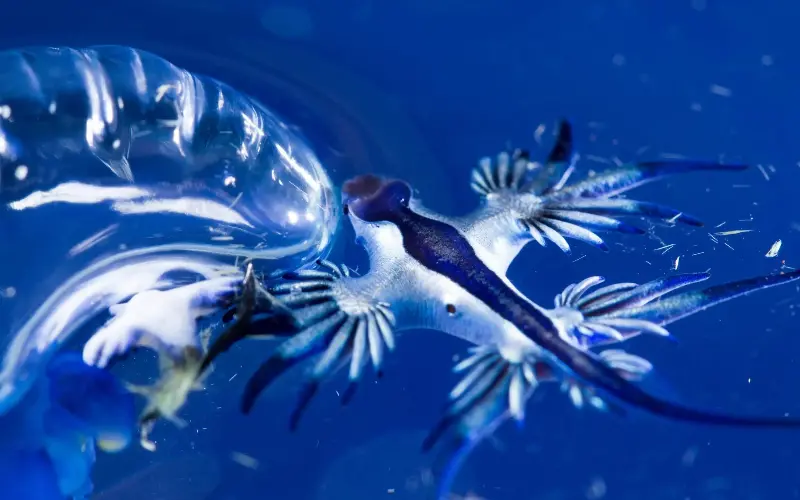
A few downpours can really put a dampener on a break. But what about a flood of seriously venomous sea slugs or a super-tornado?
The perils of India’s monsoon and the Caribbean’s hurricane season are well documented, but it turns out there are plenty of other alarming events that it would be wise to avoid when booking a holiday – and some have even hit this summer.
Read on to see a round up of the most bizarre, disgusting or downright dangerous seasonal phenomena – involving insects, endless darkness and plenty of fires.
Summer
Sea slugs, Spain
August holidaymakers along the Costa Blanca’s seven-mile stretch of sand at Guardamar del Segura were recently banned from the beach due to the appearance of so-called blue dragons.
Delicately beautiful on the outside, these feathery sea slugs feed on poisonous creatures such as the Portuguese man o’war, storing their venom in concentrated doses to use in their own stings.
Encountering a blue dragon can be potentially fatal, as a sting can trigger a severe allergic reaction.
Until 2021, the species hadn’t been spotted off Spain for more than 300 years, preferring warm waters in the Atlantic, Pacific or Indian Oceans, but there have been three high summer spates in the Costa Blanca since.
Sargassum season, Caribbean
It’s not just hurricanes that hit the islands in summer: visitors also have to contend with stinky sargassum season. Prickly, and smelling like a cross between wee and rotten eggs, the green algae is having a particularly successful 2025. The Dutch Caribbean Nature Alliance reported that April seaweed levels in the eastern Caribbean and Western Atlantic were more than double that of 2022, previously a record-breaking year.
The explosion is thought to be fuelled by fertiliser run-off and warmer seas.
What’s an inconvenience for tourists is a health threat for the permanent population: the toxic gases released by the algae can lead to respiratory difficulties so, when the problem is particularly bad, schools are evacuated. Meanwhile, reefs are smothered and fishermen find their livelihoods in jeopardy as rotting sargassum invades the shoreline.
Derecho season, America
Harder to forecast than tornados and hurricanes, derechos are extreme storms linked to fast-moving rain or thunder. According to the BBC, they must cause damage over more than 250 miles, sustain gusts of around 58mph along their full length and reach wind speeds of 75mph to qualify for the moniker.
Though not exclusively American, they mostly happen between April and August in central and eastern parts of the country – and when one hits, it can trigger several others in a catastrophic chain of events.
In April 2025, a derecho ripped through the Midwest, killing three people and leaving thousands without power.
Meltemi wind, Cyclades
While Greek island-hopping is the definition of a chic summer holiday, sailors know to swerve the Meltemi wind, which can churn the sea around the Cyclades until it is whitewater rough. Blowing north between June and September (and most likely to hit between mid-July and mid-August), the winds have spawned several cautionary YouTube videos from sailors, and can also disrupt the ferries that plough the waters between the islands and from the mainland.
Those on boats often travel in the morning or late at night to avoid the worst of the wind, anchoring when the forecast is particularly bad. Meanwhile, onshore, visitors seek out sheltered beaches such as Agios Prokopios on Naxos or Monolithos on Santorini.
Typhoon season, Japan
August and September is peak typhoon season in Japan, bringing torrential rain and winds of up to 200 kph from the north Pacific.
They’re often at their worst on the balmy sub-tropical islands around Okinawa, where huge waves pound the coastline and strong winds hit land, causing landslides and flights and ferries to be cancelled.
But the storms can reach more-visited cities such as Tokyo, too. In 2019, planes and trains were cancelled and the authorities urged people to stay inside as millions were evacuated from their homes in the city during Typhoon Hagibis.
Flying Ant Day, UK
Don’t think Britain is entirely free of its own weird weather events. Flying Ant Day, which could be anytime between mid-June to early September and – worse – actually stretches over several days, has proved enough of a nuisance for The New York Times to write a piece about it.
The phenomenon, caused by the ants meeting in the sky to mate, may get more extreme in the future as temperatures soar too.
Winter
Acqua alta in Venice, Italy
Trying to escape summer’s tourist crowds? Winter brings another bother to Venice – the floods of the acqua alta (high water).
Caused by particularly high tides and usually occurring between November and March, these fill low-lying landmarks such as St Mark’s Square, sending locals and tourists alike onto temporary elevated walkways so they can stroll above the waterline. Usually easy to manage, the acqua alta can occasionally be devastating.
In November 2019, the water was so high that it flooded 80 per cent of the city and damaged precious churches and monuments including Palladio’s Tablino, built in the 1560s as the sacristy for the Chiesa della Carità. The phenomenon is such a nuisance that there’s an official app to keep track of it (hi!tide Venice).
Polar Night in Svalbard, Norway
The glaciers of this Norwegian archipelago draw visitors in search of polar bears and whales when summer rolls around. By mid-November they’ll be hard to spot though, because the region is thrown into Polar Night. At this time of year, the sun never gets beyond six degrees above the horizon, plunging the area into perpetual darkness.
Morning segues to night and back again, with no discernable difference. Locals use head torches to light their way along icy paths but mostly hunker down at home. For the tourists that do make the trip during winter, one incredible sight might make up for the blackout: the neon glow of the aurora borealis, visible when the sky is cloudless.
The Mistral, France
Marseille residents stay indoors when its famous wind hits (usually in winter and early spring). Blowing south through the Rhône Valley towards the Mediterranean, it brings chilly gusts of up to 100kph to Provence.
At its most extreme, it can bring down trees, cause flight disruption and fan wildfires due to its dry nature: in early July 2025, gusts of 70kph helped propel one dangerously close to the edge of the city.
Some locals forecast the Mistral’s arrival by nighttime scarlet skies and treat it with reverence: after all, the wind dries the grapes and blows away any cloud cover, ensuring precious vines get the sunshine needed for the best wine.
Stinger Season at the Great Barrier Reef, Australia (also early spring)
From November to May, a particularly poisonous stinger inhabits the warm, shallow waters of Northern Queensland. The box jellyfish comes with up to 60 venom-packed tentacles which really pack a punch: the unluckiest people to encounter them die from cardiac arrest caused by a reaction to stings.
As a result, a public awareness programme urges swimmers to wear full-length wetsuits and swim at patrolled beaches – and it’s worked. Barrier Reef Australia figures suggest there’s now one fatality every three or four years from box jellyfish stings, compared with 20-50 in the Philippines, where they’re just as prevalent.
Spring
Burning season, northern Thailand
During March, smog hides the view from the northern Thai city of Chiang Mai while residents don N95 masks to help them breathe. It’s the heart of burning season, when farmers set fire to the surrounding fields in preparation for new crops (despite it being illegal in the country), adding an extra layer of pollution for three or four months at the beginning of every year.
The air quality is often so bad that it’s spawned a profusion of Reddit threads from concerned tourists and ex-pats, who’ve experienced stinging eyes, headaches and sore throats.
